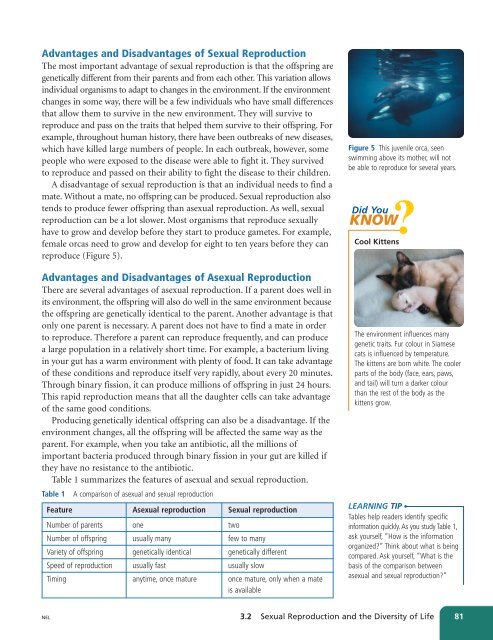Unit A Reproduction
Unit A Reproduction
Unit A Reproduction
You also want an ePaper? Increase the reach of your titles
YUMPU automatically turns print PDFs into web optimized ePapers that Google loves.
Advantages and Disadvantages of Sexual <strong>Reproduction</strong><br />
The most important advantage of sexual reproduction is that the offspring are<br />
genetically different from their parents and from each other. This variation allows<br />
individual organisms to adapt to changes in the environment. If the environment<br />
changes in some way, there will be a few individuals who have small differences<br />
that allow them to survive in the new environment. They will survive to<br />
reproduce and pass on the traits that helped them survive to their offspring. For<br />
example, throughout human history, there have been outbreaks of new diseases,<br />
which have killed large numbers of people. In each outbreak, however, some<br />
people who were exposed to the disease were able to fight it. They survived<br />
to reproduce and passed on their ability to fight the disease to their children.<br />
A disadvantage of sexual reproduction is that an individual needs to find a<br />
mate. Without a mate, no offspring can be produced. Sexual reproduction also<br />
tends to produce fewer offspring than asexual reproduction. As well, sexual<br />
reproduction can be a lot slower. Most organisms that reproduce sexually<br />
have to grow and develop before they start to produce gametes. For example,<br />
female orcas need to grow and develop for eight to ten years before they can<br />
reproduce (Figure 5).<br />
Advantages and Disadvantages of Asexual <strong>Reproduction</strong><br />
There are several advantages of asexual reproduction. If a parent does well in<br />
its environment, the offspring will also do well in the same environment because<br />
the offspring are genetically identical to the parent. Another advantage is that<br />
only one parent is necessary. A parent does not have to find a mate in order<br />
to reproduce. Therefore a parent can reproduce frequently, and can produce<br />
a large population in a relatively short time. For example, a bacterium living<br />
in your gut has a warm environment with plenty of food. It can take advantage<br />
of these conditions and reproduce itself very rapidly, about every 20 minutes.<br />
Through binary fission, it can produce millions of offspring in just 24 hours.<br />
This rapid reproduction means that all the daughter cells can take advantage<br />
of the same good conditions.<br />
Producing genetically identical offspring can also be a disadvantage. If the<br />
environment changes, all the offspring will be affected the same way as the<br />
parent. For example, when you take an antibiotic, all the millions of<br />
important bacteria produced through binary fission in your gut are killed if<br />
they have no resistance to the antibiotic.<br />
Table 1 summarizes the features of asexual and sexual reproduction.<br />
Table 1<br />
A comparison of asexual and sexual reproduction<br />
Feature Asexual reproduction Sexual reproduction<br />
Number of parents one two<br />
Number of offspring usually many few to many<br />
Variety of offspring genetically identical genetically different<br />
Speed of reproduction usually fast usually slow<br />
Timing anytime, once mature once mature, only when a mate<br />
is available<br />
Figure 5 This juvenile orca, seen<br />
swimming above its mother, will not<br />
be able to reproduce for several years.<br />
Did You<br />
KNOW?<br />
Cool Kittens<br />
The environment influences many<br />
genetic traits. Fur colour in Siamese<br />
cats is influenced by temperature.<br />
The kittens are born white. The cooler<br />
parts of the body (face, ears, paws,<br />
and tail) will turn a darker colour<br />
than the rest of the body as the<br />
kittens grow.<br />
LEARNING TIP<br />
Tables help readers identify specific<br />
information quickly. As you study Table 1,<br />
ask yourself, “How is the information<br />
organized?” Think about what is being<br />
compared. Ask yourself, “What is the<br />
basis of the comparison between<br />
asexual and sexual reproduction?”<br />
NEL<br />
3.2 Sexual <strong>Reproduction</strong> and the Diversity of Life 81

















